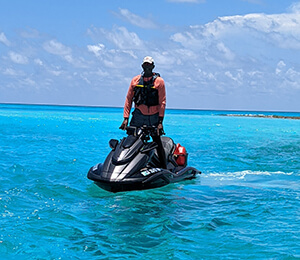
Frank Taylor in the blue waters of Bimini.
I was fortunate enough, recently, to knock another item off my bucket list. I finally got around to making the crossing from Florida to Bimini!
Years ago, when I first got the idea, the plan was to do the crossing by boat. Back then, I had a boat that I could put on a trailer. Life happened and I eventually sold the boat before I had a chance to do the trip. Since my current boat is not trailerable, I decided to change the plan a bit and do the crossing on my jet ski.
As you can imagine, such an adventure requires more preparation than just taking your ski out for a spin on the lake. It goes way beyond just ensuring that you have life jackets and fire extinguishers. Failure to prepare properly could result in some disastrous results.
After all, we were heading out into the ocean well beyond the sight of land. Let’s talk about some of the extra things we did to make sure this trip was as safe as possible.
- Travel in numbers – I could not imagine crossing from Florida to Bimini on a jet ski by myself. People have done it. However, in our case, we had 27 jet skis making the trip together. Traveling in numbers can make things a lot better should someone have an issue along the way.
- Watch the weather – Weather is always important when spending time on the water. It is even more important when taking on a trip like this. We started watching the weather two weeks out and we delayed our departure by one day due to weather. It was “better to be safe than sorry.”
- Ensure your equipment is up to the task – For us, making sure our skis were in good shape and ready to go was important. It’s one thing to have a breakdown on the lake, but encountering mechanical issues out at sea is even worse.
- Communication – Your cell phone is not going to work when you are miles out in the ocean. Even though we were never out of sight of each other during the crossing, each of us came prepared with a marine radio to make communication within the group easier. It also would make it easier to communicate with other vessels or call for help if necessary.
- Have a fuel plan – We were able to complete the crossing on one tank of fuel. A good fuel plan always allows for the unexpected. Each of us carried extra fuel just in case conditions caused a higher rate of consumption than expected. It is better to have it and not need it than to need it and not have it.
- Know where you’re going – We made sure that each ski in the group had its own GPS chart plotter with the routes programmed in. This ensured that everyone knew the route to our destination even if they got separated from the pack.
- Personal locator beacons – Each person on the trip had their own personal locator beacon. The chance of someone getting separated from the group and needing assistance was very slim but this was an added precaution.
In addition to the items above, we also had all the things that one should expect to have along on any jet ski ride: An anchor, fire extinguisher, life jackets, fenders, lines for towing and docking, etc.
We were fortunate in that our trip went without a hitch and everyone returned safely without any incidents. Even though we did not have to use any of this additional safety equipment, the peace of mind it provided made the trip that much more enjoyable.
Photo: courtesy of Frank Taylor





